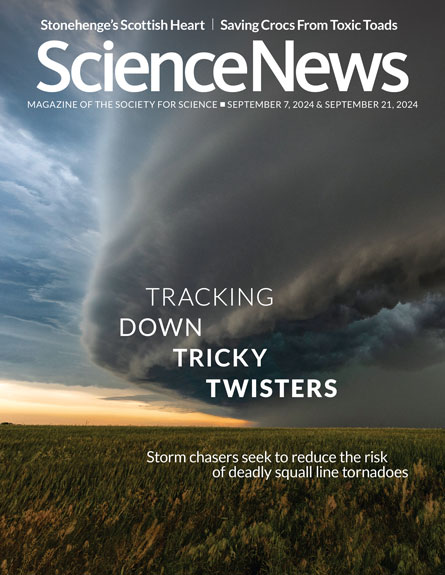Icy moves
Stonehenge’s central stone, known as the Altar Stone, may have had Scottish and not Welsh origins, researchers say. The finding suggests that Late Neolithic groups had long-distance connections, Bruce Bower reported in “Stonehenge’s roots extend to Scotland” (SN: 9/7/24 & 9/21/24, p. 10).
Reader Ralph Bradburd wondered if a glacier, not humans, could have at least partly transported the Altar Stone from Scotland to southern England, where Stonehenge is located.
That scenario is worth considering but is unlikely, says geoscientist Anthony Clarke of Curtin University in Perth, Australia. Ice sheet reconstructions show that glaciers moved northward from the Grampian Mountains in central Scotland toward the Orcadian Basin in the northeast, where the Altar Stone is thought to have come from, he says. So glacial movement up there would not have brought the Altar Stone south to Stonehenge.
What’s more, there is little evidence of rocks deposited by glaciers, known as glacial erratics, in central southern Britain, Clarke says. And specifically, erratics from Scotland have not been found near Stonehenge.
Up in the air
Cloud-forming aerosols may be forged during stratospheric air intrusion events, in which Earth’s jet streams cause stratospheric air to dip into the underlying troposphere, Carolyn Gramling reported in “Earth’s jet streams sow cloud seeds” (SN: 9/7/24 & 9/21/24, p. 12).
Reader James W. Benefiel asked whether it’s more likely for clouds to form when water vapor in the upper troposphere condenses on particles.
This is actually a known mechanism for the formation of cloud condensation nuclei, the tiny particles that water droplets condense onto and which are the genesis of clouds, Gramling says. Such particles can form where convective clouds, such as thunderstorm clouds, carry gases or tiny particles from Earth’s surface high into the atmosphere, where water vapor can condense onto them.
What this new study suggests is an entirely different chemical process for cloud formation, which involves ozone from the stratosphere, Gramling says. Stratospheric air intrusion events were already a known phenomenon. Now researchers have linked such events to a bump in the formation of cloud condensation nuclei. The scientists propose that the mixing of stratospheric ozone with tropospheric moisture, catalyzed by sunlight, may increase the production of free hydroxyl radicals, which can react with other molecules to create the cloud-forming particles.
Given the frequency of stratospheric air intrusion events, this mechanism may be a significant source of cloud nuclei, Gramling says. But just how much is still unknown.
Friend or foe?
A chemical analysis suggests that the asteroid that killed the dinosaurs came from beyond Jupiter, Carolyn Gramling reported in “Dinosaur killer’s origin revealed” (SN: 9/7/24 & 9/21/24, p. 7).
The story sparked a lively discussion on Reddit about whether Jupiter shields Earth from asteroid and comet collisions.
Reddit user DonManuel wrote that Jupiter’s failure to protect Earth from the dino-killer shows “how important the protection of Jupiter really is for life on Earth.” But user Astromike23 wrote that the idea that Jupiter shields Earth from impacts is a myth.
Indeed, Jupiter’s role as a planetary protector is not so clear-cut. The planet’s immense gravitational pull can influence the orbits of nearby objects, which could be a double-edged sword for Earth.
Some studies suggest Jupiter may defend Earth and neighboring planets from impacts by pulling passing asteroids and comets toward itself or flinging them out of the solar system entirely. But other research suggests Jupiter can also slingshot asteroids and comets into the inner solar system and set up a collision course with Earth or its neighbors. Jupiter may even attract objects that wouldn’t normally pass Earth, increasing the likelihood for collision.


